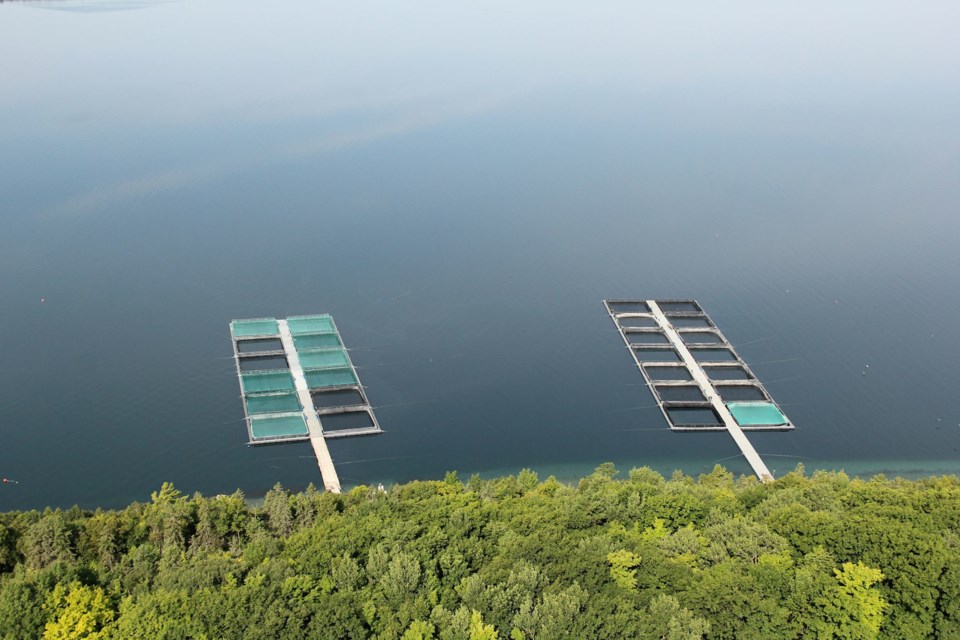Nicholas Huber is spreading the word about aquaculture.
Huber, the senior aquaculture development officer for the Waubetek Business Development Corporation, said there has been “a great uptake” for a federally-funded program that helps Indigenous entrepreneurs set up fish-rearing operations in their communities.
More than 15 partners in northeastern Ontario have begun the process of setting up the aquaculture facilities funded through the Northern Integrated Commercial Fisheries Initiative.
But these days, it’s not just about raising fish. The easiest way to describe the future of the industry, Huber said, is “underwater agriculture.”
“Anything that grows in water, including vegetables, is a form of aquaculture,” Huber said.
In addition to Manitoulin Island’s several open-net fisheries, the new approach includes different types of operations like recirculating aquaculture systems, also known as land-based farming.
”Those are man-made structures that have a source of water and have the ability to recycle up to 99 per cent of the water being used,” Huber said. “It cleans and constantly reuses and recycles. “We also have aquaponics, which is a discipline of growing fin fish and using the wastes for the vegetation,” he said.
“Essentially, you can grow leafy head lettuce and tomatoes and cucumbers, and a lot of different things.”
Ontario Farm and Food Care estimates that Ontario’s fish farms – which currently specialize in rearing trout – add over $122 million to the province’s coffers. The annual harvest is estimated to be over 8,000 tonnes of seafood.
That’s a boon for Indigenous communities as the Ontario Aquaculture Association (OAA) estimates that 75 per cent of the trout raised in Ontario are in tandem with First Nation partners.
“The demand globally for seafood is unreal,” Huber said, noting that current ecological pressures could mean the country’s wild fisheries – like the dozens of salmon farms in British Columbia – face sustainability challenges in the long term.
“Something's got to give,” Huber said, “and aquaculture has taken on a larger role.”
Additionally, an increase in the number of health-conscious consumers opting for domestically-grown and raised food is also helping spur growth in the aquaculture industry.
According to the OAA, there has been a 135 per cent increase in annual seafood production since 2011, a number that’s likely to grow following post-pandemic concerns about supply chains and food supply.
“Aquaponics, specifically, has become quite popular through the pandemic,” Huber said. “A lot of interest in that technology, mainly due to food sovereignty and food security, which is a major challenge going forward.”
And the demand for farm-raised fish is there, Huber said. Most of Canada’s farmed seafood is exported to one of the largest global markets. Our neighbours to the south import over $3.4 billion annually, the Department of Fisheries said in a 2021 report.
But despite the industry's global implications, Huber said the process to set up a farm begins at the community level. It’s an approach that involves “mostly listening” at the onset.
“It definitely doesn't happen overnight. These projects take multiple years from start to finish.”
Although for confidentiality reasons Huber shied away from identifying those communities, he said they share the same motivations for getting involved in aquaculture.
“Some communities are looking for that economic driver to help create jobs and some wealth within the community, and some really good opportunities,” Huber said. “For others, the pandemic was a really big eye-opener,” he said.
“So a lot of these communities decided that if there's another pandemic, we have to be able to provide from within.
“There's a lot of drive to be more self-sufficient and to [establish] food security.”
Aquaculture facilities have also been a boon for the community’s workers.
Facilities can employ aquaculture technicians, biologists, and operations managers, among others. Median wages for the industry, according to Statistics Canada, are around $25 an hour, with a high range of over $40.
But how much hands-on work is needed, or how many people should be employed at the farm is, again, Huber said, predominantly a community decision.
“Almost every community that we have the pleasure of working with always has the youth on their minds,” Huber said. “How can we include the youth, whether that's grade school, or high school-aged kids, and how can we find them a home and experience within these projects?”
Despite the upside to aquaculture, Huber said Ontario’s operations, including those around Manitoulin Island and the North Channel of Lake Huron, have managed to avoid large community pushback, something fish farming operations in B.C. have long had to contend with.
The Georgian Bay Association, a community-based advocacy group representing over 3,000 families on Georgian Bay, has voiced its concerns to the province about open net pen aquaculture operations.
In January 2022, the group penned a letter to federal Fisheries and Oceans Minister Joyce Murray and Environmental and Climate Change Minister Steven Guilbeault suggesting that steps should be taken to support migration of water-based farms to land-based facilities.
But Huber said in its 30-year history of fish farming, Ontario operations have shown they can be not only sustainable, but also pose no burden to the ecosystem.
“I'm very happy to say that there hasn't been any detrimental effects by having these farms in the area,” Huber said. “Clearly, we would have seen it by now.” “I would confidently say the industry is very committed to protecting the water, the ecosystems and the areas that they operate.
“Because there's a lot at stake. There's community well-being, there's the economics, the environment, there's a lot at play,” he said. “And it's in everybody's best interest to ensure that farms are managed in a good sound way.“



